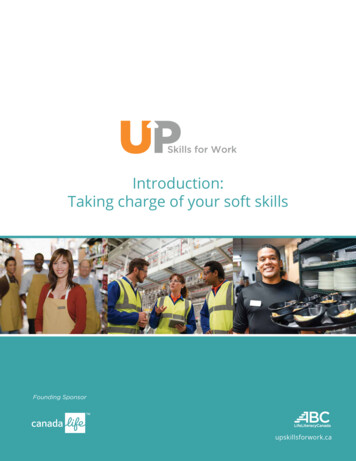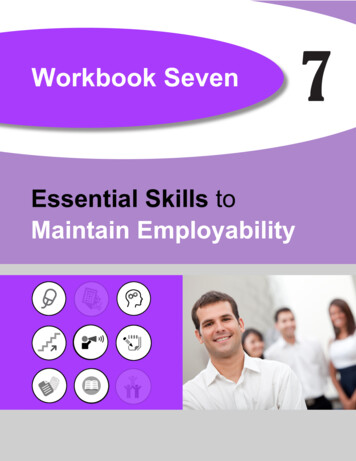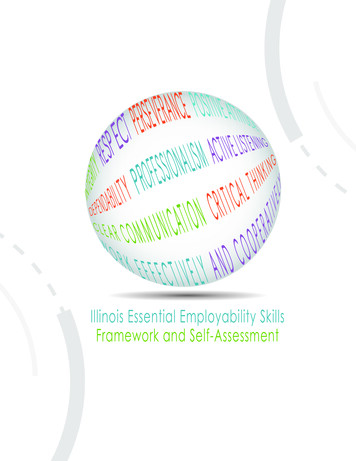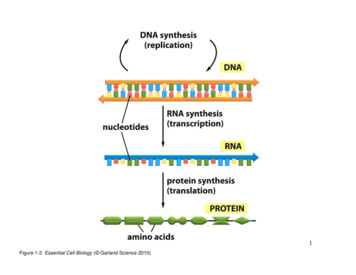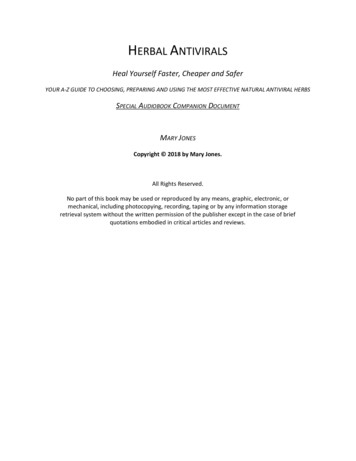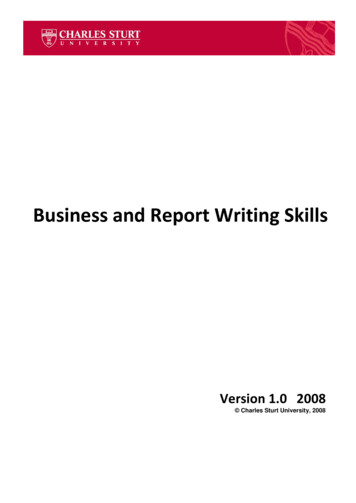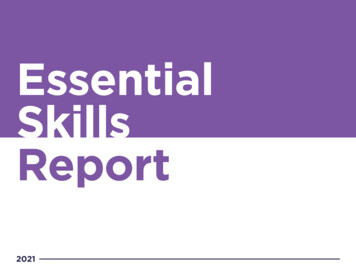
Transcription
EssentialSkillsReport2021
Table of ContentsINTRODUCTION. 02ACKNOWLEDGMENTS. 03WHY DO ESSENTIAL SKILLS MATTER?. 04WHAT ARE ESSENTIAL SKILLS?. 06How We Got Here.06Defining the Six Essential Skills.09METHODOLOGY: GATHERING THE DATA.12WHERE IS THE GAP?. 14Notes on the Skills Gap Data. 15In Their Own Words: Quotes From Young Professionals. 16Overall Findings. 16WHERE ARE STUDENTS LEARNING THESE SKILLS?. 20INSIGHTS BY INDUSTRY: ALIGNMENT AND VARIATION.22Advanced Manufacturing. 23Global Design: Architecture, Engineering and Construction. 24Finance and Insurance. 25Information Technology. 26Life Sciences. 27CONCLUSION AND RECOMMENDATIONS.28For Educational Insitutions and Out-of-School Experience Providers. 29For Employers.30Addendum: Agilities.30APPENDIX.32Study Overview. 33Survey Respondents.34Survey Findings: Communication. 35Survey Findings: Collaboration. 36Survey Findings: Critical Thinking. 37Survey Findings: Interpersonal Skills. 38Survey Findings: Proactivity. 39Survey Findings: Executive Function. 40
ESSENTIAL SKILLS REPORTExecutive SummaryAs recent high school and college students, the young professionals alsoprovided much-needed information about the various in-school and outof-school experiences that gave them real advantages. Descriptions offormative experiences confirmed that Essential Skills are largely beingacquired outside the high school and college environment, contributingto inequities. They also verified the existence of a skills gap between howimportant a skill is in the workplace and how prepared they felt uponentering the workforce. Self-reports on preparedness suggest perceivedgaps may widen by gender and race.In 2016, KC Rising released the Common Sector Competencies report,clarifying the skills valued by employers to help teachers and schooldistricts align teaching and learning with the demands of the workplace.Many schools embraced the Common Sector Competencies, andteachers put into practice instruction to build and enhance these skills.As implementation grew, educators asked for help in prioritizing the 23Common Sector Competencies.Representatives from industry and education worked with learners tofurther refine and clarify the competencies. As part of that collaborativeeffort, a research team from the Urban Education Research Centerconvened young professionals who had entered the workplace in theprevious one to five years to provide real world feedback on what it takesto enter and succeed in the world of work. They confirmed six categoriesof competencies as Essential Skills. These are:This study validates the importance of the Common Sector Competenciesand the instincts of educators to focus on building a set of core skills. Aset of recommendations is included to enhance Essential Skill buildingsystematically and systemically so that quality and access are improved andskill mastery is measured and documented. It will take the continued resolveand intentionality of educators and industry working together to betterprepare learners with the Essential Skills needed to succeed in the future. Communication – The ability to adapt within various channels, toconnect effectively with clients, co-workers, supervisors, and othercollaborators. Collaboration – Cohesive teamwork that recognizes and leverages theskills and knowledge of colleagues across a range of disciplines. Critical Thinking – Problem-solving that synthesizes information,anticipates new challenges and opportunities, and builds strategiestoward workplace effectiveness. Interpersonal Skills – Treating others with empathy and respect,building trusting relationships, and creating a sense of belonging andshared purpose. Proactivity – Taking the initiative to seek out and act on opportunitiesto learn, innovate, and add value to an organization. Executive Function – The self-accountability needed to workindependently, manage tasks and resources to meet deadlines, anddeal with ambiguity.02
ESSENTIAL SKILLS REPORTAcknowledgmentsKC Rising’s Education PlatformThis work is a product of collaboration. Special recognition goes toDeBruce Foundation for underwriting the study and report. Also, thank .you to our study partners and employers, without whom this study wouldnot have been possible.Learners of all ages need access to continuous, innovativeeducation to meet evolving workforce needs.Study PartnersBecause the rate of technological advancement andchange in our global economy continues to increase, morethan half of today’s schoolchildren will soon have careersin occupations that don’t currently exist. Meanwhile,businesses struggle to find the talented workers they needto fill high-quality jobs now and create more in the future.These organizations helped shape the study, guide the process, encourageparticipation, and share findings: DeBruce Foundation Ewing Marion .Kauffman Foundation KC Rising KC STEM Alliance PREP-KC Real World Learning Urban Education .Research Center Workforce PartnershipTo effectively address this gap, talent and potential must be recognized,maximized, and met with resources and attention across the learningcontinuum. A foundation of technical knowledge, along with CriticalThinking and Communication skills, allows learners of all ages to remaincompetitive. Building an agile culture of enduring, well-rounded educationwill keep involved citizens inventing, creating, and thriving.EmployersThis work is aligned with KC Rising, a regional economic developmentinitiative formed in 2015 to help KC grow faster and more intentionally. .KC Rising is business-led, metrics-driven, and focused on the long term.Industry-led cooperation, alongside flexible credentialing, createstrailblazing regional talent-to-work pipelines by connecting classroom andreal-world learning with hiring. This system should strive to remain nimbleand responsive as our economy evolves. KC is proudly at the forefrontof this movement, with engaged stakeholders focused on measurableoutcomes. We must continue to reimagine, disrupt, and transform.KC Rising’s goal: achieving a regional prosperity for all by aligning andaccelerating community effort. KC Rising measures progress against 10benchmark metros that we typically compete against. The goal is for KC torise in rank among these metro regions to boost the economy for everyone.To accomplish this, KC Rising relies on a distributed implementation model,allowing for a multitude of leaders and teams to work together. Guided bya steering committee composed of business and education leaders, as wellas regional elected officials, KC Rising concentrates its efforts on systemicprogress within seven pillars of prosperity: enterprise, industry, inclusion,connectivity, culture, neighborhoods, and education.The Essential Skills Study will advance KC Rising’s shared vision bysupporting the Education pillar.03
01Why do essential skills matter?An elusive “skills gap” is mentioned in almost every conversation about ournation’s workforce – but what exactly is this gap, and what can we do about it?First, let’s define the skills in question. Technical Skills are based onfoundational knowledge or expertise in a subject. Then, there are theuniquely human skills, often referred to as “soft skills.” This second set ofskills has many names – power skills, future skills, timeless skills, or essentialskills. In the KC region, the term Essential Skills has been adopted becausethese are the skills that are increasingly important, in fact necessary inthe next economy. Already, Essential Skills are a differentiator in hiring,promotion, and retention of employees.Workers with a high competency in Essential Skills are in increasing demand.Essential Skills empower transitions and open opportunity, and are key tounlocking economic mobility. In the 21st century economy, jobs follow skills.04
ESSENTIAL SKILLS REPORTWith multiple factors in flux on the technicalside, Essential Skills don’t evolve as quickly. AnOctober 2020 article published by Chief LearningOfficer describes an “interdependence of humanand technical skills” that demands a new skilldevelopment framework. Experts estimate thatmost skills have a “half-life” of about five years,with the most technical capabilities at just 2 1/2years. Therefore, a base of new Technical Skillsmust constantly be rebuilt as they lose relevanceover time, while changes in Essential Skills occurover decades as opposed to months or years. Theframework outlined in this report identifies threecategories of skills:1. Perishable Skills: Technology skills, especiallythose related to specific vendors, platforms,or programming languages that are updatedfrequently.2. Semidurable Skills: Field-specific technologies,processes, or tools that frame a baseknowledge. These are replaced as the fieldgrows, expands, and evolves.Moreimportant thanPerishableSkillsField-specificknowledgebases thatevolveMay stayrelevant foryearsAlso calledTechnical SkillsPERISHABLESKILLSSEMIDURABLESKILLSEx: Software,vendor-specifictools, teamprocessesMust beconstantlyrefreshed andupdated3. Durable Skills: A base layer of mindsets anddispositions. Not just a “way of thinking,” buttangible, teachable, and measurable skills.CRITICAL THINKINGEssential Skills serve as the roots that feed andnourish the development of Durable, Semidurable,and Technical Skills. An emphasis on thedevelopment of Essential Skills is important to thesuccess of students as they transition into careers.These Essential Skills are the foundation of agilityin an increasingly volatile world.PROACTIVITYCOLLABORATION05EXECUTIVE FUNCTIONCOMMUNICATIONINTERPERSONAL SKILLS
02What are essential skills?How We Got HereIn 2016, the KC Rising Human Capital Common Sectors Competencies (CSC)Task Force released the Common Sector Competencies report, designed toclarify the skills valued by employers across all sectors of the workforce. Thereport, which attracted widespread interest, created a common language foremployers, employees, teachers, schools, and school districts to discuss andcollaborate on P-20 workforce development.As the CSC framework was implemented across Kansas City, educatorsbegan asking for additional guidance. Specifically, they asked for help inprioritizing the 23 competencies and translating them into language thatstudents could understand. In 2017, work began to refine and clarify thecompetencies.06
ESSENTIAL SKILLS REPORTTIMELINE: KC WORKPLACE PREPAREDNESS OMPETENCIES(CSC)REPORT20162017STEMCONNECT 1820192020REALWORLDLEARNINGLAUNCHEDThe Integrating Common Sectors Competenciesworkgroup gathered feedback from teachers, highschool students, and young professionals. Havingentered the workplace in the past one to fiveyears, the young professionals supplied valuableinsight about what it takes to enter and succeedin the workplace. As recent high school andcollege students, they also provided much-neededinformation about the various in-school and out-ofschool experiences that gave them real advantages.Focus groups with young professionals acrossKansas City allowed us to identify six categories ofcompetencies, or Essential Skills: Critical Thinking,Collaboration, Communication, Interpersonal Skills,Executive Function, and Proactivity. They describedthe relationship between skills as hierarchical,with Communication and Executive Functionserving as the baseline abilities. They talked aboutthe strong connection between Communication,Interpersonal Skills, and Collaboration, emphasizingthe importance of adaptability and creativity acrossall categories.In 2019, more than 350 young professionalsweighed in, validating the importance of the skillset and describing their own experiences anddevelopment. This report builds off the work of theCommon Sector Competencies by leveraging thisdata for further insight into the skills required tothrive in the modern workplace.07
ESSENTIAL SKILLS REPORTSHARED VALUES AMONGKC INITIATIVESKC Rising:Common Sector CompetenciesThe DeBruce Foundation:Agile Work ProfilerKauffman Foundation:Portrait of a GraduatePLTW:Transportable Skills Working with information InnovatingTHINK Critically think Exhibit discernment Adaptive problem-solving Make reasoned decisions Critical and creative thinking Problem-solving Selling and communicatingRELATE Tech-savvy Communicate Communication Managing Developing othersRELATE Collaborate Collaboration Serving and caringRELATE People-savvy Value differences Show integrity Organizing ManagingCONTRIBUTE Be accountable Earn a livingCRITICAL THINKING Use basic applied mathematicsSolve complex problemsThink criticallyInterpret and apply dataCultivate innovationCOMMUNICATION Speak influentially Listen actively Write efficientlyCOLLABORATION Collaborate Attract and develop talent Build effective teamsINTERPERSONAL SKILLS Focus on customer Instill trust Value differencesEXECUTIVE FUNCTION Plan and alignManage ambiguitySelf-developmentManage projectsManage complexity Ethical reasoningTHRIVE Express agency Seek and use feedback Manage ambiguity Comfortable to fall and recoverPROACTIVITYLEARN Growth mindset Reflect and adapt Curious and flexible Drive results Display courage Be flexible and adaptiveCONTRIBUTE Find and create opportunities Create value for othersTHRIVE Be courageous08 Mindset
ESSENTIAL SKILLS REPORTDefining the Six Essential SkillsCOMMUNICATIONCOLLABORATIONWith platforms constantly evolving, the ability to adaptwithin various channels to connect effectively with clients,coworkers, supervisors, and other collaborators is critical.Effective teamwork is the engine that drives organizationstoward their goals. Cohesive teams recognize andleverage the skills and knowledge of colleagues acrossa range of disciplines.What young professionals said: Being able to communicate well is the cornerstone of InterpersonalSkills, Critical Thinking, and Collaboration.What young professionals said: Teams happen every day. Recognizing the importance of contributingand collaborating on a team, as well as knowing how to positively dealwith conflict, is essential. Listening first and then communicating with co-workers, organizationalleadership, and clients is one of the most important skills to master. The ability to translate industry jargon and upper-level concepts intomore digestible terms is critical to client work. Workforce collaboration involves working with a diverse array ofpeople in a multitude of ways. Success with this requires the ability .to step into a variety of roles. Contacting the right people in the right way is vital, as well as choosingthe correct tone and level of formality depending on the audience .and situation. An essential part of team success is mutual understanding of .personal priorities and schedules – i.e., recognizing when people .are busy and knowing how to follow up in a professional manner .to keep moving forward.What does it look like? Communicate effectively and in a timely manner through differentmediums (including phone, in-person, email, and videoconferencing). Collaboration involves coming together as a team to mergeindependent work. Learning how to give and receive constructivefeedback is vital to a positive environment. Effectively negotiate, present, persuade, and advocate for yourself .and for your company.What does it look like? Adaptively read a situation and effectively respond. Effectively lead, manage, delegate tasks, and work with teams. Communicate organizational goals and purpose clearly. Foster teamwork, common goals, and individualized .learning experiences. Develop a shared sense of purpose within teams while .encouraging others. Recognize and utilize individual strengths and different perspectives.09
ESSENTIAL SKILLS REPORTCRITICAL THINKINGINTERPERSONAL SKILLSWith access to more information than ever before,effective thinkers not only synthesize information but alsoanticipate new challenges and opportunities, and buildstrategies that increase their workplace effectiveness.People with strong Interpersonal Skills treat others withempathy and respect, build trusting relationships, andcreate a sense of belonging and shared purpose that isvital to success.What young professionals said:What young professionals said: Workplace problems often have many potential solutions. The .ability to think through these options and avenues and choose the .best fit is crucial. Projects may require input from multiple departments, so goodrelationships and mutual respect are crucial to working effectively .and efficiently. When encountering unforeseen roadblocks, Critical Thinking is vital .in problem-solving and getting back on track. Key components of this skill include knowing how the team is going towork together, recognizing that people bear stress in different ways,and having empathy about what people are going through. Critical thinking includes using existing skill sets and knowledge tosolve problems and make decisions, but also knowing when and whereto ask for help and track down information. The ability to read a social situation and predict how people are goingto react to certain actions helps determine how to act with and aroundbosses, co-workers, and clients. The ability to think outside the box while creating strategies andsolutions that are tailored to the clients’ goals and objectives can be .a differentiator for an organization. When dealing with sensitive subjects, it is important to know how toask personal questions while being respectful and polite.What does it look like?What does it look like? Identify and solve problems. Empathize, interpersonally communicate, and develop .social relationships. Develop innovative strategies for implementation and the execution .of plans. Be flexible, adaptive, and creative in problem-solving strategies. Build trust with others and foster an environment of emotional .and psychological safety. See things from multiple perspectives to identify the best solution. Resolve conflict and treat others with dignity and respect. Recognize and serve personal needs with a positive outlook .and attitude.10
ESSENTIAL SKILLS REPORTPROACTIVITYEXECUTIVE FUNCTIONIndividuals who take initiative propel themselves towardsuccess. Curious, self-starting workers seek out and acton opportunities to learn, innovate, and add value to anorganization’s growth.Self-accountability, or “adulting,” is a fundamental skillin the workforce. Knowing how to work independently,manage tasks and resources to meet deadlines, and dealwith ambiguity leads to professional success.What young professionals said:What young professionals said: Proactivity is the ability to understand what is possible within anorganization, have the willingness to do something different, and thenmake the decision to pursue it, following through on an organizationaland individual level. The autonomy that comes with a job creates the responsibility tomanage time, responsibilities, projects, personal growth, and mistakes. Self-management and organization don’t have a universal approach.Individuals must discover what learning, managing, and organizationstyles work best for them. There are no step-by-step instructions in the workforce. The only wayto make progress on projects and in your career is by actively seekingout opportunities to learn and grow. When timelines are derailed, it’s imperative to know how to reprioritizeand reevaluate what needs to be done, managing resourcesthroughout the process. Harnessing the enthusiasm to learn and develop is key to career success. Learning how to fail fast and forward is a must in the workforce. Theresilience built from making mistakes is a cornerstone to productivityand proactivity. It can be easy to become overwhelmed, but stress can be minimizedwith a plan and focal points for the day.What does it look like?What does it look like? Effectively plan and prioritize, self-monitor and regulate. Recognize work that needs doing and initiate tasks. Manage resources (monetary, time, etc.) to deliver quality results. Be curious about your work, ask questions, and seek feedback fromothers with experience. Navigate stressful situations in a constructive manner and .maintain focus. Identify areas for and take initiative toward organizational change .and improvement. Maintain emotional control and professionalism at work .through planning.11
03Methodology:Gathering the Data12
ESSENTIAL SKILLS REPORTKC-AERC launched the Young Professionals Survey with support from .KC Rising, KC STEM Alliance, Prep-KC, Workforce Partnership, The DeBruceFoundation, and The Ewing Marion Kauffman Foundation. Efforts were madeto ensure that young professionals in KC Rising’s fastest-growing industrysectors, young professionals of color, and young professionals working in theKansas City metro area were represented in the sample.In May 2019, the Kansas City Area Education Research Consortium .(KC-AERC) conducted focus groups with 14 young professionals acrossindustry sectors in the Kansas City metro area. Participants were askedto describe the Essential Skills used within their workplaces and to giveexamples of experiences that influenced these skills. Findings from thefocus groups, in combination with input from industry leaders and existingresearch, resulted in the specification of the six Essential Skills and formedthe basis of the Young Professionals Survey.More than 350 young professionals – defined as a person who has been .out of school and in the workforce for one to five years – completed thesurvey. The final sample included 10% African-American, 13% Hispanic,and 62% white young professionals. Two-thirds worked in the Kansas Citymetro area, and 83% worked in one of KC Rising’s top industry sectors.The gap in preparation of Essential Skills has been a primary concern inKansas City. The goal of the Young Professionals Survey was to betterunderstand the gap in these skills and opportunities for growth. The surveyasked young professionals three questions:1. How important are these Essential Skills to your current job?2. Thinking about these Essential Skills, how prepared were you when .you started your job?3. What had the biggest impact on your Essential Skills in high school .and college?13
04Where is the gap?Employers are facing real skill gaps in hiring, and the most pronounced are inEssential Skills. In a survey of 704 employers across industries, the Chronicleof Higher Education found that half said they had trouble filling vacancies intheir companies, noting that even though most applicants had the TechnicalSkills, many lacked the Essential Skills needed to be successful.In a national study of millions of job postings, Burning Glass Technologiesfound that one in three postings explicitly requested Essential Skills, withemployers even overemphasizing these capabilities, suggesting they wereundersupplied in the candidate pool. According to the Workplace LearningReport by LinkedIn, Essential Skills training was the No. 1 priority for talentdevelopment in 2018.The job posting and employer data provide an important look at the skillsgap from the employer perspective. This report focuses on the skills gapfrom the young professionals’ point of view, providing employee perspectiveon the issue. Taken together, they provide a fuller understanding of theextent of the skills gap and potential solutions to address the problem.14
ESSENTIAL SKILLS REPORTGAPS BETWEEN PREPAREDNESS AND IMPORTANCE59%Notes on the Skills Gap DataTo assess the Essential Skills gap among young professionals, weanalyzed data for each Essential Skill. We calculated the percentage ofyoung professionals who indicated the Essential Skill was “important”or “very important” to their jobs, and then the percentage of youngprofessionals who felt “moderately,” “very,” or “extremely” prepared inthat Essential Skill when they started their jobs. The difference betweenthese two percentages was classified as the gap.92%COMMUNICATION55%85%EXECUTIVE FUNCTION62%Young professionals’ perception data help us understand the waythey conceptualize and value workplace skills, as well as their sense ofpreparedness (or lack of preparedness) upon entering the workplace. Animportant reminder about occupational perception data is that it reflectsrespondents’ perceptions of themselves, their self-confidence, and senseof belonging. We know from established research that women and youngprofessionals of color report lower levels of confidence, belonging, andskill attainment than white male young professionals, even when weconsider work performance. It is important to keep this in mind wheninterpreting the data broken down by race and RPERSONAL SKILLS66%The skills gap analyses include an overview of the gap across industrysectors in Kansas City and then a set of subanalyses broken down byboth gender and race and ethnicity. The overview includes data from abroad cross-section of professionals across 20 industry sectors, including60% working in KC Rising’s five fastest-growing industries. This sampleincludes 38% young professionals of color.84%CRITICAL THINKINGThe subanalyses provide a more detailed look at the data and areintended to provide additional insight into the findings. Given the smallersample sizes in the subanalyses, we view these findings as preliminary.Further analysis, from the employer and employee sides, may revealthe roles that gender and race or ethnicity play in self-efficacy and skilldevelopment.15
ESSENTIAL SKILLS REPORTOverall FindingsIn Their Own Words:Quotes from Young ProfessionalsYoung professionals report a skills gap in all six Essential Skills. Thegap ranges from 18% for Critical Thinking to 33% for Communication.Consistent with the job posting and employer data, young professionalsreport they are underprepared when they enter the workforce.“The gap is big in Communication because internalpeople expect you to use high finance jargon – andthen learn how to completely flip it to talk about itwith clients. In school, there’s a strong emphasis onhard skills and technical language.”The Essential Skills gap is largest for Communication, Executive Function,and Proactivity. Even though the vast majority of young professionalsidentified Communication, Executive Function, and Proactivity asimportant or very important to the job, only 3 out of 5 said they wereprepared. The gap is largest for Communication, a skill that employershave consistently reported as critical and difficult to find in new hires.“Working with a wide variety of people in college –different ages, majors, levels
Essential Skills serve as the roots that feed and nourish the development of Durable, Semidurable, and Technical Skills. An emphasis on the development of Essential Skills is important to the success of students as they transition into careers. These Essential Skills are the foundation of agility in an increasingly volatile world.


